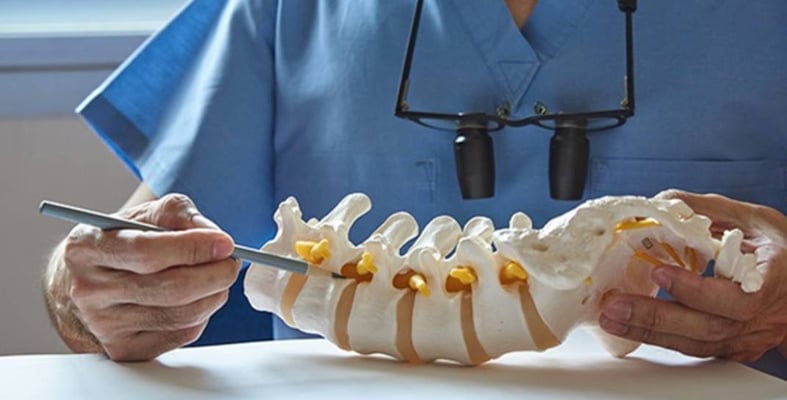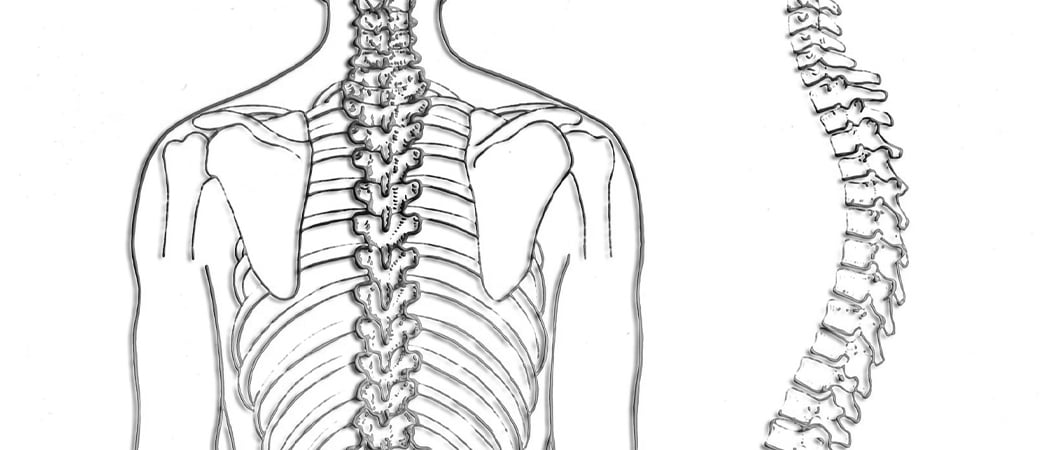Spine Surgery

In this article, we learn together what the spine is, the nature of the problems that affect it, and the symptoms that can result from any problems in spine work.
What is the spine?
It is a continuous chain of vertebrae: 7 Cervical, 12 Thoracic, and 5 Lumbar, connecting at the top with the skull, and below with the pelvis.
A single vertebra consists of a solid anterior segment, called a vertebral body, and a circular bone ring, located behind the vertebral body.
This ring forms a channel through which the spinal cord and spinal nerves pass. The resulting channel is called the Spinal Canal.
Between each vertebra and the next there is a cartilaginous disk which is the shock-absorbent mechanism of the spine, it is arranged circular cartilage rings, one inside the other, and inside the inner ring, there is a gelatinous substance in the center.
With age and the consumption of the vertebrae and the joints between them, degenerative changes occur in the spine and in the cartilage discs between the vertebrae, where those discs lose water content, and weakness occurs in some rings, which leads to a Leads to protrusion in the gelatinous material inside the ring inside the rings into the spinal canal or nerve exits, Which causes compression and irritation of the nerves.
Besides, degenerative changes can occur in the joints between the vertebrae, which may lead to narrowing of the spinal canal and nerve exits, putting pressure on the nerves and causing some pain in the buttocks and leg area. These Changes may occur at any level of the spine, but often they occur in the cervical or lumbar vertebrae.

What are the symptoms of herniated disc and/or degenerative changes of the spine?
Cervical spine problems:
Symptoms include neck pain in addition to other symptoms caused by pressure on the exits of the spinal nerves, such as:
- Weakness in the hand or arm.
- Numbness in one of the hands or arms.
- Pain and burning sensation in one of the hands or arms.
Lumbar spine problems
Symptoms include the occurrence of pain in the lower back, in addition to other symptoms caused by pressure on the exits of the spinal nerves, such as:
- Shooting pain that extends to the lower extremities, especially to the area below the knee.
- Weakness in one of the lower extremities.
- Numbness in one of the lower limbs.
- In advanced cases, problems with urination may occur, such as urinary incontinence, or urinary retention, or numbness in the perineum, and in these cases, surgical intervention is urgently required.
- And when non-surgical treatments fail to control pain, or in case of severe weakness in the body, a surgical intervention is indicated.
How is spine problems diagnosed?
MRI is the gold standard for diagnosing for diagnosing all problems of the spine, and accordingly the operation is planned, the affected vertebrae and the place where the operation will be performed are identified.
Before Surgery
The medical team investigates the patient’s medical and surgical history in detail, making sure that the patient has no allergy to any drugs to some treatments, and some routine tests are also performed on samples of the patient’s blood.
Post-operative care includes wound care, pain relief, and some physical therapy. A day after the operation, the patient can leave the hospital to complete the hospitalization period at his home.
What complications can happen after the operation?
Back and neck spine operations are safe but, like any operation, they are not without potential complications, where their rate is as low as 5%.
The most common complications of lumbar spine operations:
- Complications from anaesthesia.
- Inflammation of the wound.
- Nerve injury.
- Dura mater injury and Cerebrospinal fluid leak.
- Persistence of pre-operative pain symptoms in a few cases.
The most common complications of cervical spine operations:
- Wound inflammation.
- Complications from anaesthesia.
- Pain in the neck.
- Nerve injury.
- Difficulty in swallowing.
What activities can the patient perform after the operation?
The patient can return to his normal life after the operation, and practice all non-strenuous activities, as long as those activities do not cause pain, and despite this, it is best to avoid any strenuous work, such as: running, weights lifting, or other violent sports.
Is spine surgery the right choice for you?
Consult our doctors in Ilajak Medical, to provide you with a free consultation regarding spine operations, send us X-ray pictures, MRI and medical reports, and if the operation is the most appropriate option, we arrange a medical trip to Turkey, from the moment you arrive at the airport to surgical and physical therapy, and we accompany you in all stages of your medical trip, until the moment you return with the best results, healthy and well.
Do you have an inquiry? Contact us - For FREE Consultation.
Ilajak Medical© | A passion for care




Treatment Services
In the Best Medical Centers
Contact Us
Please fill the form below and describe your condition, We will contact you back
- Dental Treatment
- Hair Transplant
- Obesity Surgery
- Vision Correction
- Health Resorts
- Other Medical Services
- No elements found. Consider changing the search query.
- List is empty.
Your personal data is processed as indicated in the general statement text and by continuing, you explicitly consent to the processing

